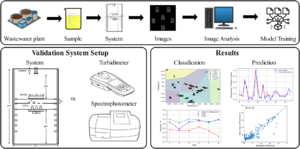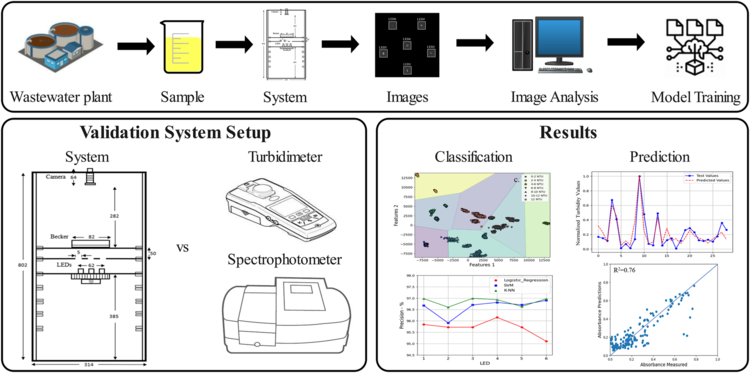
Recent advancements have significantly improved turbidity and absorbance measurement techniques, crucial for municipal and industrial wastewater quality monitoring. This experimental system utilizes image analysis and machine learning on monochrome-camera images of real secondary wastewater effluent samples, irradiated with six LEDs, to classify turbidity and predict absorbance in the visible range. It focuses on low turbidity measurements (0–15 nephelometric turbidity units [NTUs]), the hardest challenge for conventional turbidity sensors. Specifically, this camera-based technique was able to classify within a 2 NTU class, 96 turbidity samples collected from a real wastewater treatment plant with precision and accuracy of over 96%. Additionally, it effectively predicted turbidity and absorbance with a neural network, achieving R-squared coefficients of 0.76 and 0.72, respectively. This innovative monitoring system, deployable in several locations of a wastewater treatment plant, not only addresses the limitations of the existing methods for the low turbidity range but also brings the potential for plant-wide process monitoring. Further testing is in progress to validate the proposed approach in other wastewater applications, such as combined sewer overflow monitoring and waste-activated sludge upset detection where more extreme and rapid changes are expected to occur.
Source code: https://osf.io/x5z2v/
Keywords[edit | edit source]
computer vision, monitoring, absorbance, camera-sensor, LEDs, machine learning, turbidity, wastewater monitoring
Highlights[edit | edit source]
- Camera-based sensor to monitor and detect anomalies in wastewater treatment plant.
- Machine learning methods applied to image analysis of low turbidity range.
- Turbidity classified from 0 to 15 NTU with an interval size of 2 with accuracy >96%.
- Absorbance in the visible range is simultaneously predicted.
See also[edit | edit source]
- OS Computer Vision for Distributed Recycling and Additive Manufacturing
- Additional OS Computer Vision Applications














